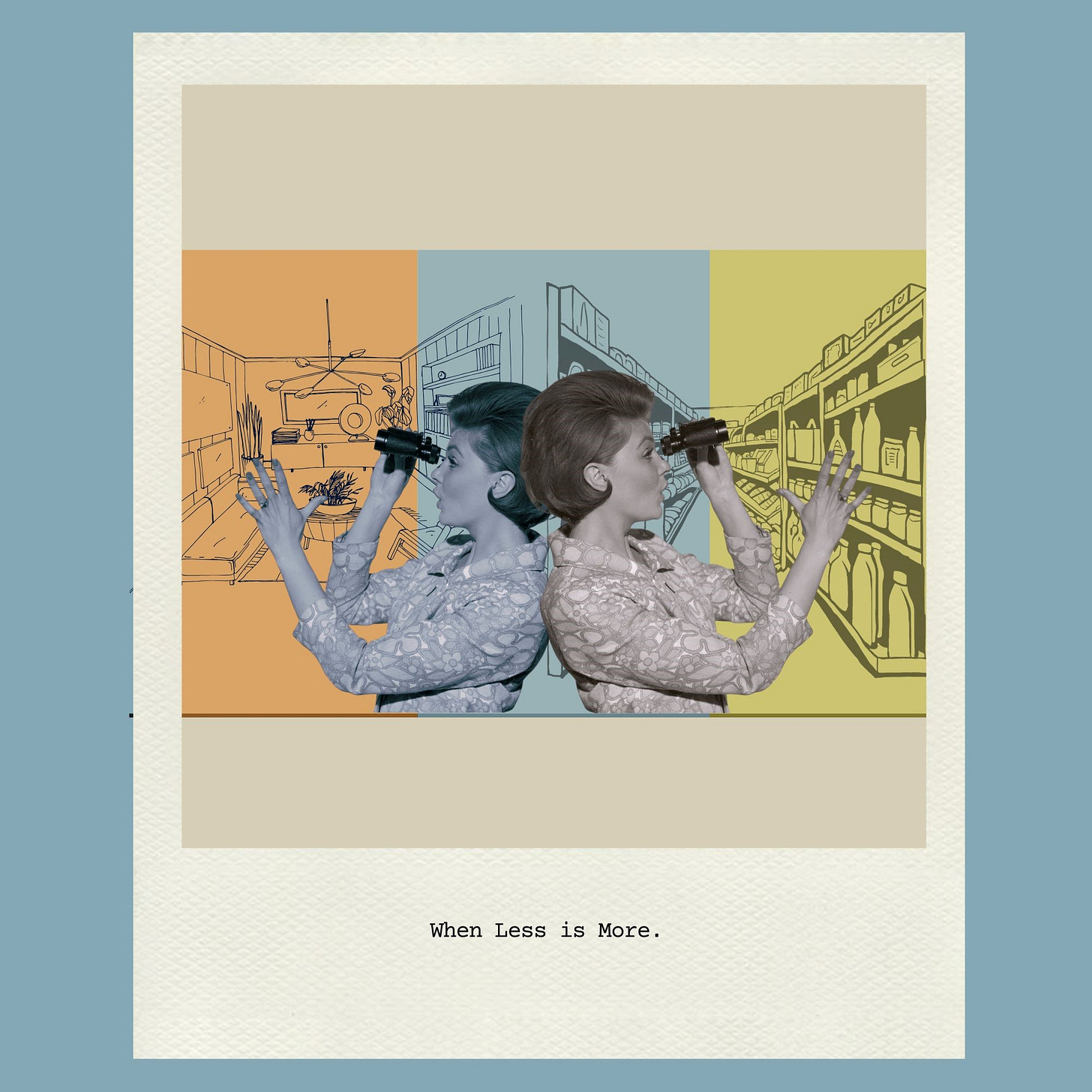When Less is More

My longtime grocery store has closed. It was small, organic, employee-owned. It had what I wanted, on shelves I could find blindfolded. I knew the managers and grieved with them as the end drew near.
But the day came, and I had to find a new store to call my own. I started with a local supermarket. Walking in, I felt like Rip Van Winkle. The food shopping world had changed while I was away. The lights were so bright, the air so chilled, and the choices so vast.
The shelves held things I couldn’t imagine anyone wanting, like dill-pickle-flavored cashews. Other things left me baffled: dairy-free pepper-jack-style shreds? Of what?
An old friend’s phrase, “wretched excess,” came to mind.
I was dazzled, but also repelled, mostly for environmental reasons. There were too many one-purpose gadgets, like a container for a 5-inch slice of watermelon. There was endless plastic. (To be honest, there was a lot of plastic in the organic store, too. Our world is saturated with it.) The talent that created the endless variety seemed wasted to me.
Mega-choice isn’t new. Thirty years ago, a scene, in the movie “L. A. Story” spoofed coffee orders.
Tom: I’ll have a decaf coffee.
Trudi: I’ll have a decaf espresso.
Morris Frost: I’ll have a double decaf cappuccino.
Ted: Give me decaffeinated coffee ice cream.
Harris: I’ll have a half-double decaffeinated half-caf, with a twist of lemon.
After that, everyone else wants a twist of lemon, too.
The scene might not be funny today. The situation (minus the lemon twist) is too ordinary. Starbucks now claims to have 87,000 different drink combinations; some mathematicians calculate it as 300 billion. Really.
On the one hand, this vast expanse of choice enriches our lives. On the other, it consumes them.
Recently I discovered cold brew coffee, and in the summer I love it. But it comes in many brands, and each brand in many varieties: bold, bright, mellow, smooth, espresso, etc. These, in turn, can be not too sweet or unsweet. Flavors galore as well: peppermint mocha, pumpkin, cappuccino, latte, and so on. So I need to investigate, think, and then choose.
I also have to watch more closely what I put in my cart. That first day I bought, by accident, something called “Cashewmilk yogurt.” Next time I paid more attention. Having so many choices wears me out. Obama wore a blue or grey suit every day, saving his decision energy for more important issues.
Mega-choice isn’t confined to groceries or clothes, and it’s not confined to my own choices. In the digital world I need to keep track of what others choose. When I touch base with friends, I do it through text or email. Some of my friends use only one or neither; some use WhatsApp, FaceTime, or apps I’ve never heard of. The results can be awkward. Recently a good friend asked me why I was ignoring her calls. I protested; I would never! But I had been. She was calling on WhatsApp, which was off my radar.
Years ago I became fixated on Vernors diet cream soda. A very specific preference, and one that became harder and harder to satisfy. At some point, the soda stopped being produced. Today that’s a constant danger for all sorts of products, but again coffee is a prime example. Starbucks’ new fall menu includes something called Apple Crisp Oatmilk Shaken Espresso. It might become my favorite. It also might disappear forever, once winter arrives.
The larger the set of choices, the more specific our desires become—and so more vulnerable to disappointment.
FOMO: The fear of missing out. Settling on one choice might make me miss another that I’d like better.
Again, the problem goes far beyond food. The world today offers more possibilities than even the most fortunate can explore. I could spend my retirement years binging on classic movies, studying fractals, visiting state parks, campaigning for electoral reform, writing a blog. But I can’t do them all. And everything I don’t do hovers somewhere out there as an opportunity missed.
The advantages of more choice are obvious: new possibilities offer new pleasures and open windows on a wider world.
But there’s a limit and no formula to tell me what it is. Besides, the limit varies from person to person and domain to domain. For me, any bookstore is a patch of heaven, and even a single new app is a danger zone.
I’m settling again into default preferences, which save so much time and energy. I know there’s a fine line between useful habits and a closed mind, but research finds that “satisficers” enjoy life more than “maximizers.” That’s a relief.
And so, I remind myself regularly that choosing to ignore possibilities—to stay home rather than go out, to pass over the newest kind of mustard or digital device—can be a positive choice. It will clear space in my mind, and make room for quiet in my life.




I have never been a FOMO type of person. But just recently I have learned that there is also an acronym for aging curmudgeons like me. JOMO. The joy of missing out. It makes me feel so socially embraced and vindicated!
I'm with you! Before a conference I helped organize, the main organizer made the mistake of sending a message to members asking about their food preferences and allergies. We were swamped with myriad replies about everything people wouldn't or said they couldn't eat, including one who said she was desperately allergic to arugula. Too much choice!